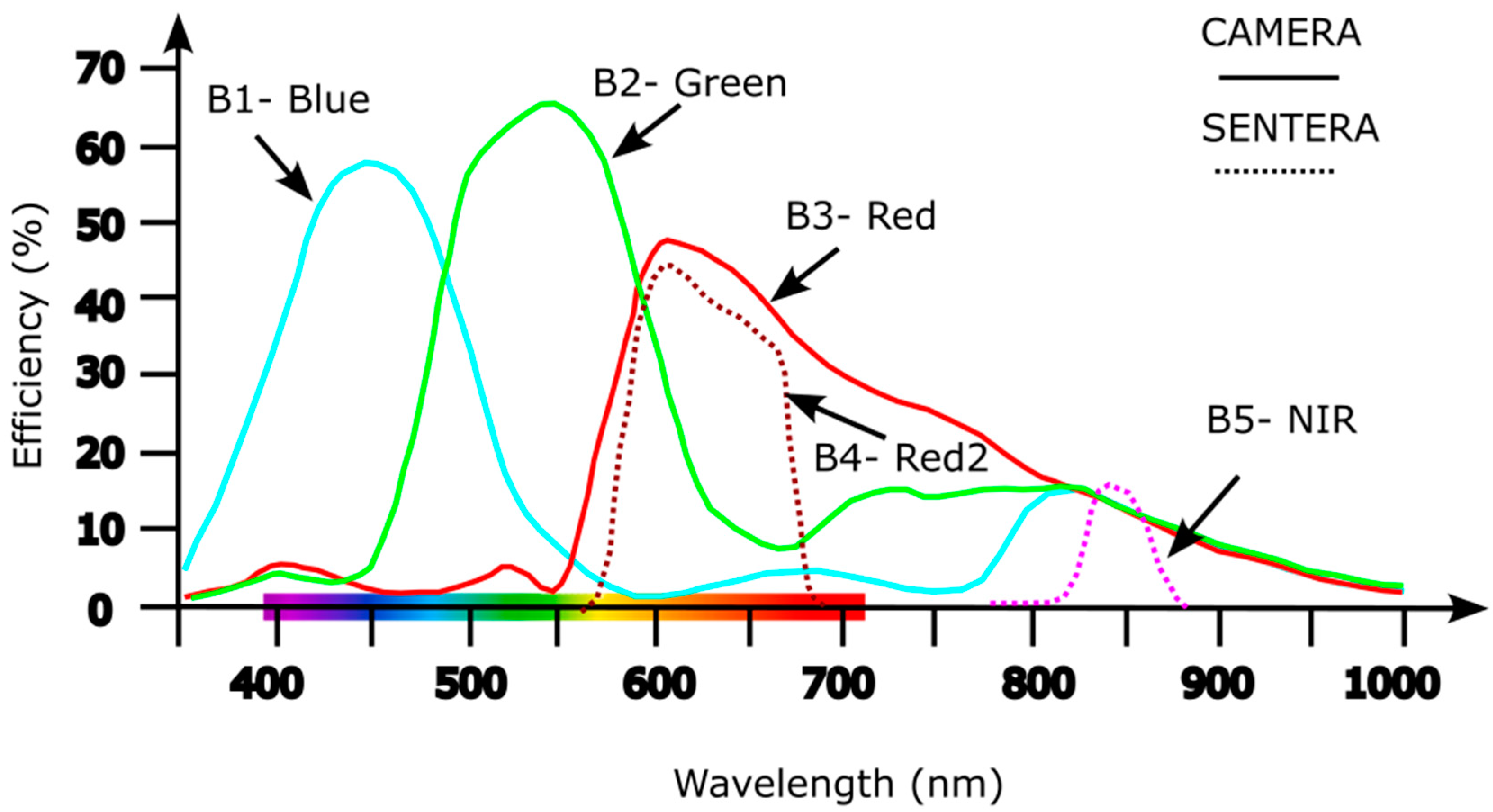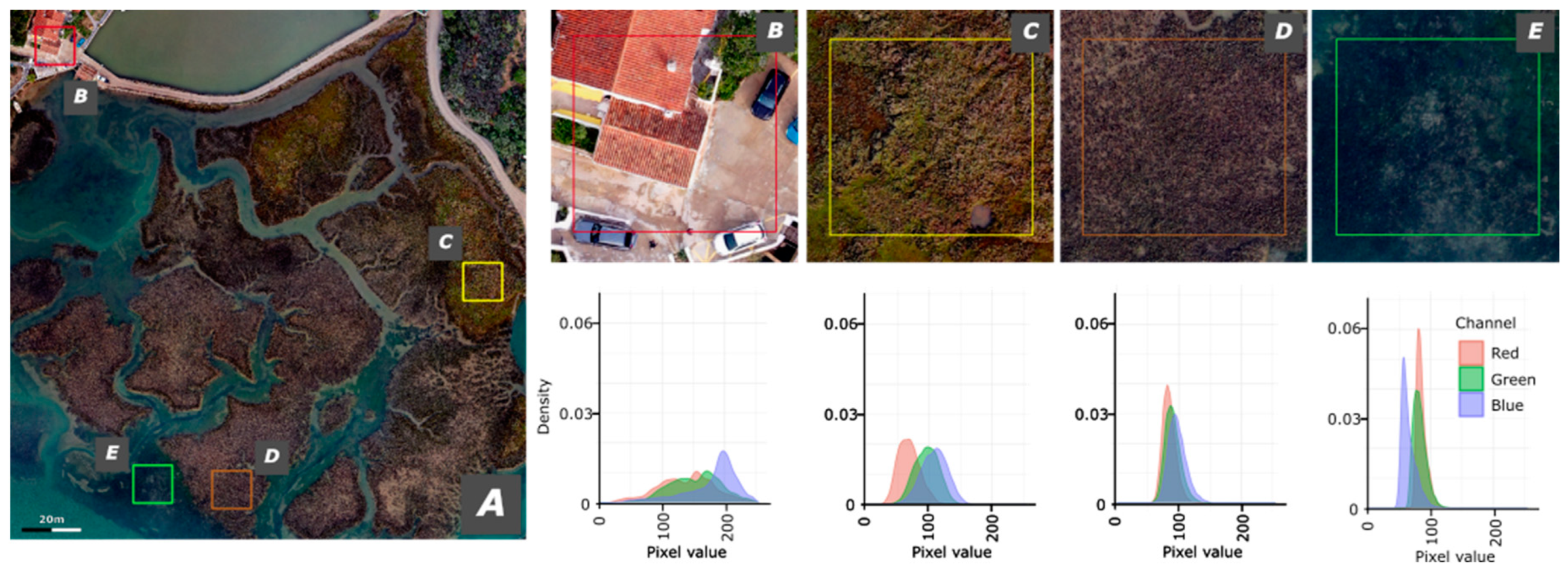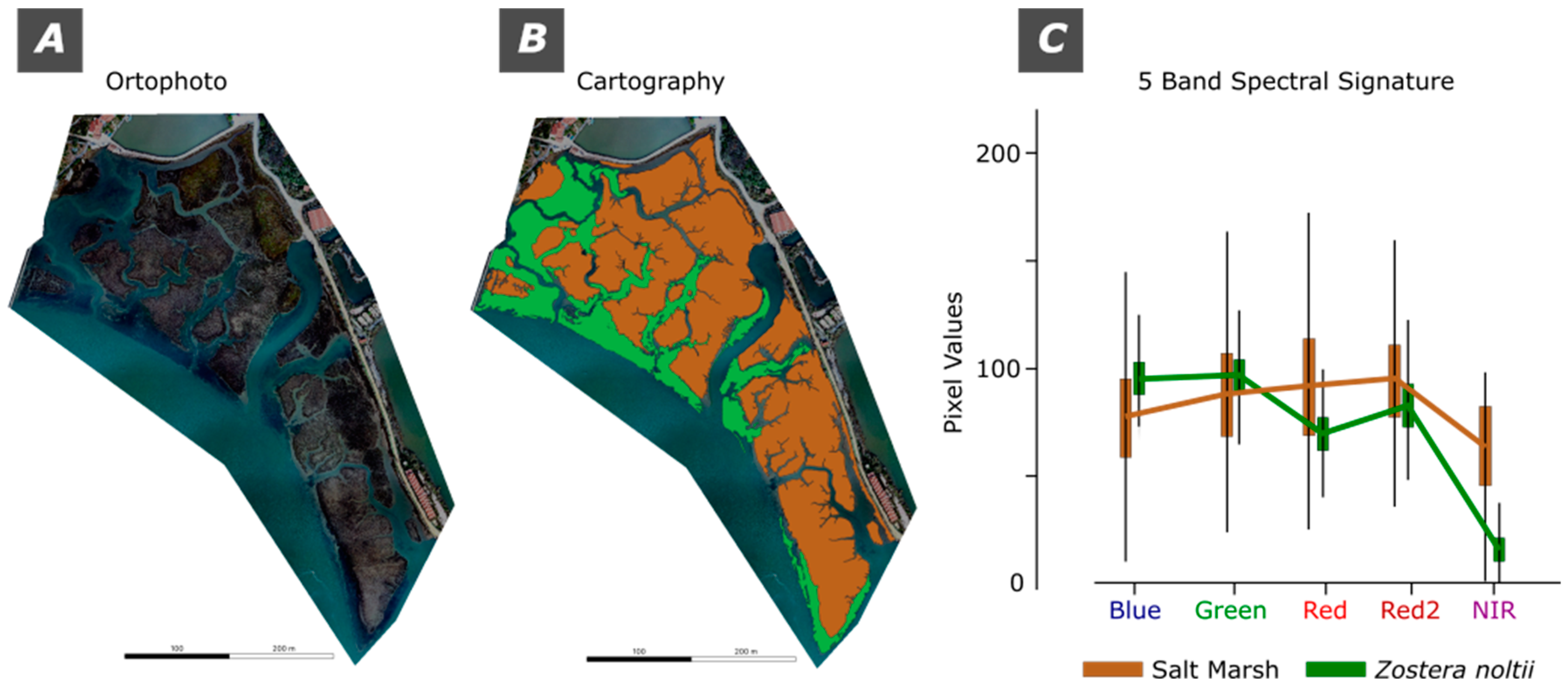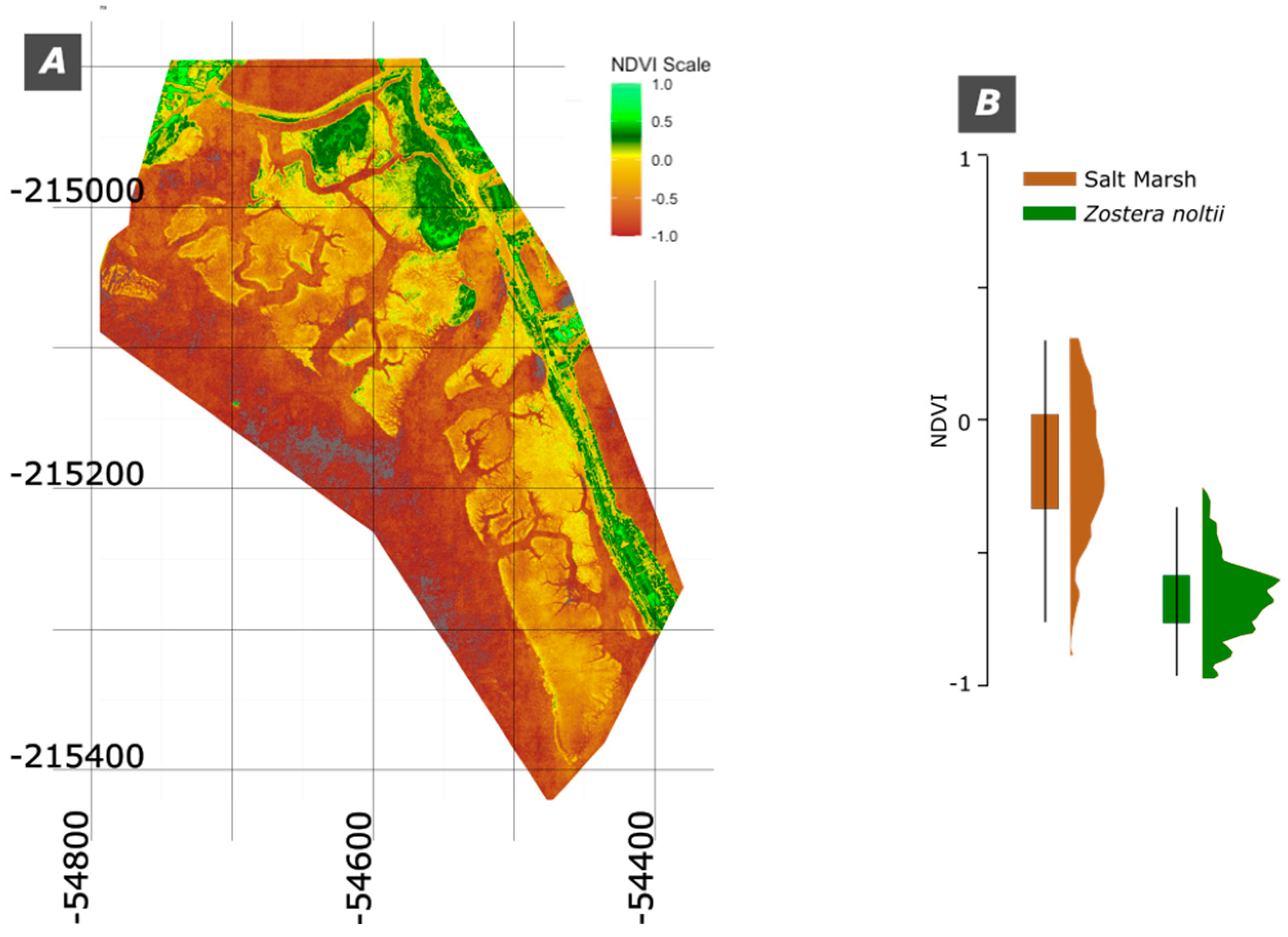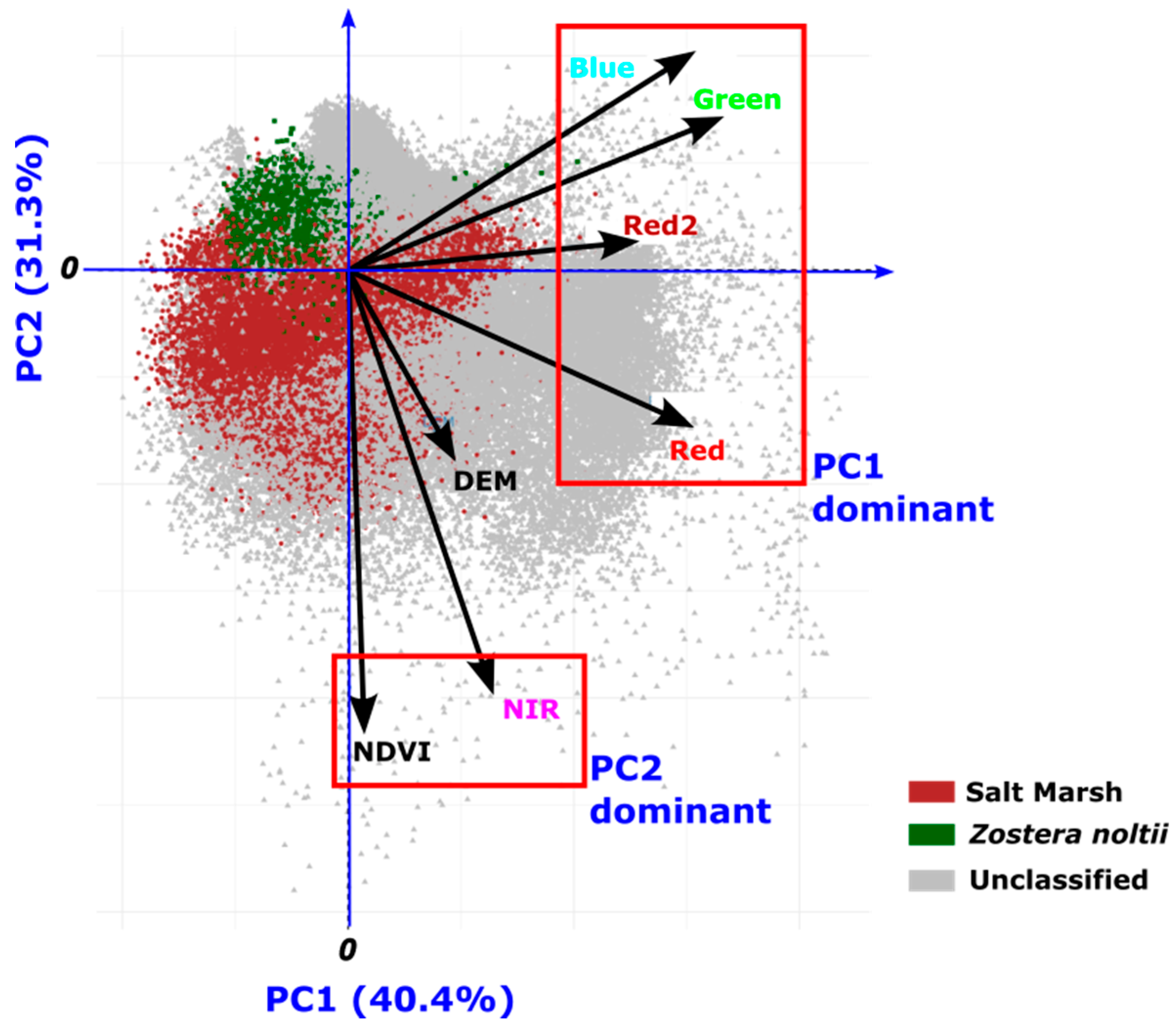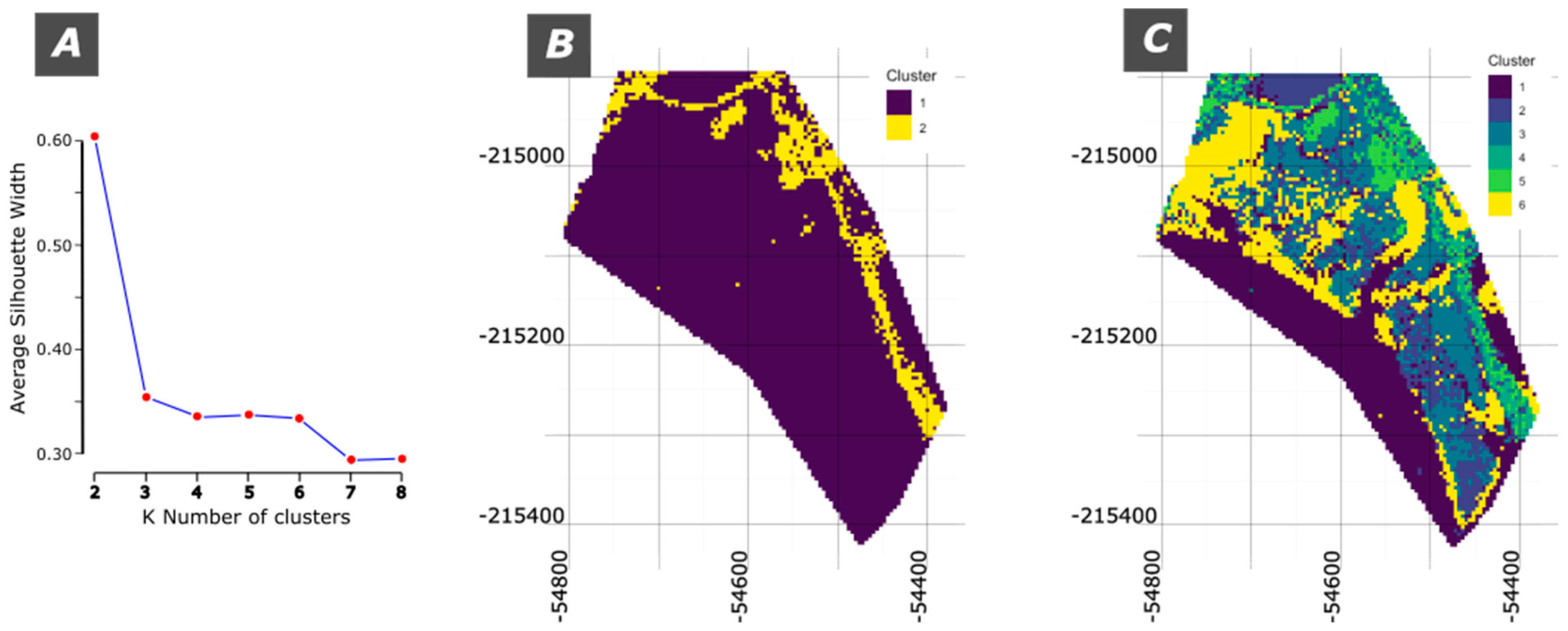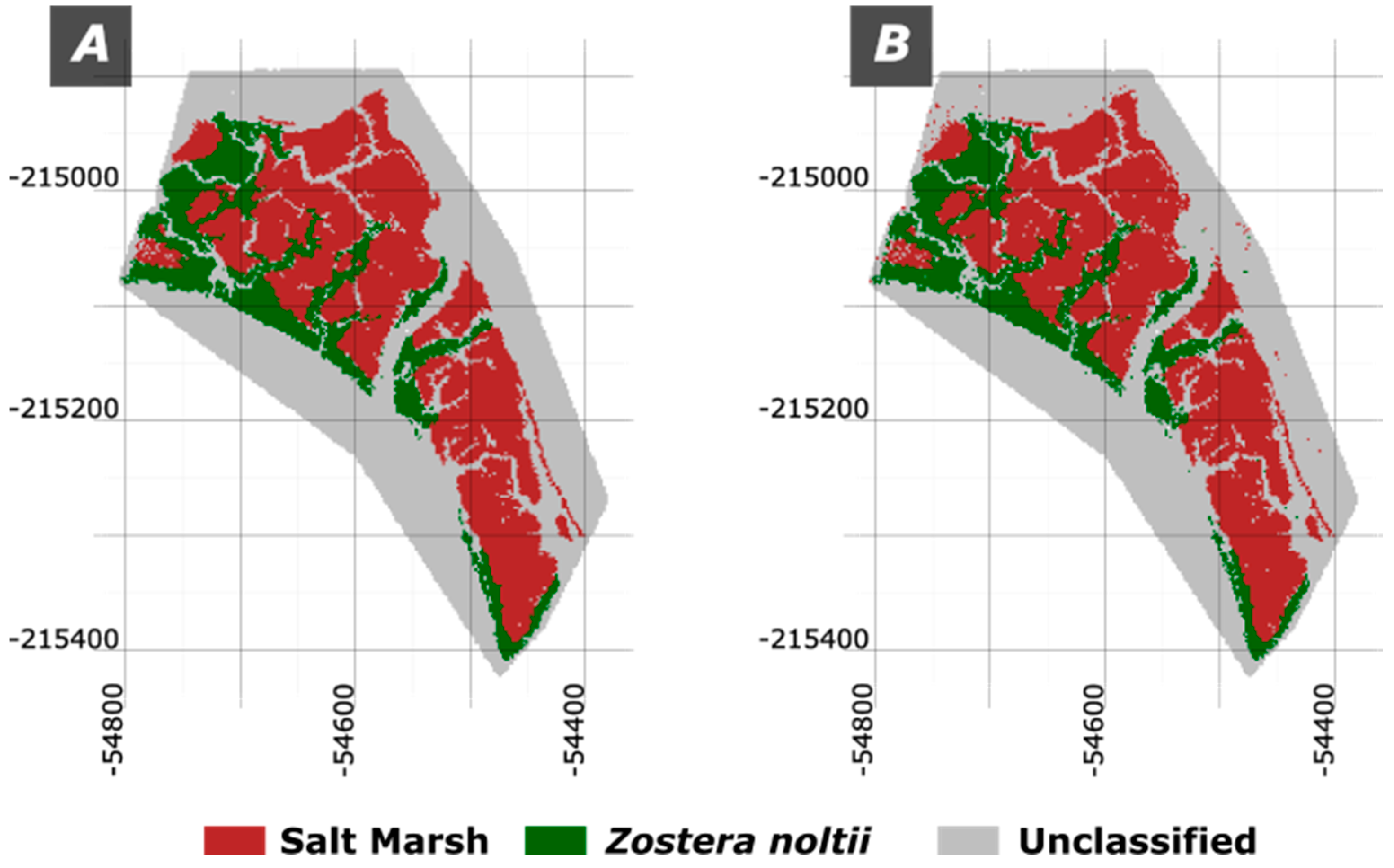1. Introduction
Seagrass beds comprise some of the most heterogeneous landscape structures of shallow water estuarine and marine ecosystems in the world and are reported to be in decline globally [
1,
2]. These beds play important ecological roles in coastal ecosystems, providing high-value services, are typically considered ecosystem engineers, are crucial in structuring assemblages, and are important sinks for organic carbon, providing co-benefits [
3,
4].
The intertidal seagrass beds of
Zostera noltii in the Mira estuary (SW coast, Portugal) are undergoing a natural recovery process after a major collapse in 2008, the causes of which are still unknown [
5]. Since 2009, an uneven natural recovery has been observed, with some seagrass beds having high biomass, while others have very low biomass values, with clear changes in the temporal and spatial distribution of seagrass beds in Mira estuary [
6,
7].
An effective restoration method and strategy for the recovery of a seagrass bed must be based on the knowledge of its ecological status and particularly based in the knowledge of the dynamic of its spatial and temporal distribution and variability. Monitoring, by mapping the temporal and spatial distribution of seagrass beds, provides an essential reference to plan a successful strategy for seagrass habitat recovery.
Figure 1 represents the mapping of
Z. noltii and Salt Marsh in the mouth of the Mira River, on the spring of 2022.
Often the seagrass areas are not easily accessible thus constituting a problem to accurately map the extension of the different ecotypes which implies a poor characterization of the evolution and the recovery stage process.
Among the prevalent methodologies, the utilization of satellite data remains the most widely adopted for identifying and mapping seagrass bed regions (e.g. [
2,
8,
9]). This approach is proven to be successful specially when combining the near infrared bands (NIR) with visible light in the normalized vegetation index (NDVI) (e.g. [
10,
11]). The drawback is the low temporal and spatial resolution of the free access data, not providing the necessary dates and resolution for accessing the species distribution.
Light unmanned aerial vehicles, i.e. drones, are the perfect tool for accessing these areas, and can provide high resolution imagery that is key to identify and map these ecosystems [
12,
13]. These images when acquired with enough overlap can be used to create digital elevation models (DEM) that are another important variable to study these areas.
Furthermore, the coupling of drones with multispectral cameras enhances the power of distinguishing the different ecotypes providing enhanced information to fully understand these systems. This is especially true when using a near-infrared band that help to identify the health of the vegetation [
8]
This innovative approach is combined with Machine Learning (ML) methods to map the seagrass beds of the Mira estuary and to verify the quality of the results, providing insights to the application of this methodology in worldwide seagrass beds. The use of ML, namely Random Forest methods (RF) has already proven to be useful when applied in satellite images (e.g. [
2,
14]). Our work uses the same approach but with very high spatial resolution, testing its application in mapping the seagrass beds of the Mira estuary.
2. Materials and Methods
The initial recognition and the first studies of the presence of Z. noltii beds were done by field studies in accessible areas.
For this study a Mavic 2 PRO drone equipped with a Sentera NDVI multispectral camera (SNMC) was used. This setup collects two groups of images, one with the Hasselblad camera from the drone and another one from the SNMC. Both groups of images were processed in the Agisoft software to create an orthorectified image and using the Hasselblad camera images a digital elevation model (DEM) was created from the point cloud that is generated from the overlapping images.
The orthorectified images were resampled using a script written in R programming language (R Core Team 2024). The final ground surface distance (GSD) is of 5 cm. The orthorectified images were combined in a single raster that was used for all the analytical procedures.
The sensors installed in the cameras have different spectral sensitivities and range (
Figure 2) and for each of the bands in the raster stack were assigned a number that correspond to: B1- Blue, B2-Green, B3-Red, B4-Red2 and B5- NIR (near infrared).
The analytical procedures include the exploratory data analysis (EDA), evaluation of band ratio indexes in this case the Normalized Difference Vegetation Index (NDVI), principal components analysis (PCA) and classification using both K-means and Random Forest (RF) machine learning approaches. The K-Means was tested for 3 to 10 clusters whereas RF was done with 250 trees.
Accuracy was measured using the formula [
15]:
And the Kappa value [
15] is calculated by:
Where:
is the observed accuracy (i.e., the actual agreement between predicted and true values),
is the expected agreement (i.e., the agreement expected by chance).
One must remember that Kappa values range from -1 to 1, where: i) A value of 1 indicates perfect agreement; ii) Zero indicates no agreement better than chance; iii) Negative values suggest agreement worse than chance. In practice, a high accuracy can be misleading with imbalanced data, but a high Kappa value suggests that the model is performing well beyond chance.
For this study not all the seagrass beds from the Mira estuary were studied, it was selected the seagrass area located in the Moinho da Asneira (
Figure 3), it is strongly representative of the natural recovery after a major collapse in 2008 [
5].
The focus of the study was the characterization and mapping of the two main ecotypes present in the area, i.e. a)
Zostera noltii and b) adjacent Salt Marsh, identifying all the other landscape elements as unclassified. We are aware that several other categories of elements are present in the area (e.g., terrestrial vegetation or human infrastructures, c.f.
Figure 4); however, all of these were consolidated into a single category.
4. Discussion
The visible light signatures obtained for different landscape typologies in the Moinho da Asneira area reveal distinct patterns that allow for effective differentiation between ecotypes and other land use cases, such as human infrastructure. The dispersed spectral signature of human infrastructure, with dual peaks in the Red and Green bands and an asymmetric Blue distribution, likely reflects the diversity of materials (such as bare soil, roof tiles, and metals) that interact with light differently. This varied response complicates the classification but also serves as a unique indicator, distinguishing human-made areas from natural landscapes. In contrast, the symmetrical distribution of RGB bands in land vegetation, where Blue has the highest values, Green is intermediate, and Red is lowest, aligns with expected photosynthetic activity. This pattern is characteristic of healthy vegetation and aids in separating vegetated land areas from other ecotypes. The similar spectral response across the RGB bands in Salt Marsh areas, combined with a leptokurtic peak between pixel values of 75 and 100, suggests a homogenous spectral signature that may be associated with the specific vegetation or soil characteristics unique to Salt Marsh ecosystems.
The distinct spectral signature observed for Z. noltii areas, characterized by pronounced peaks in all three bands, especially in the Red band, provides a valuable basis for its identification in multispectral analyses. The lower pixel values in the Blue band and higher values in the Red band indicate a unique spectral response that differentiates Z. noltii from other vegetative types, likely due to its specific pigmentation and structural properties.
This characteristic pattern supports the use of RGB spectral signatures for ecological mapping and suggests that multispectral imaging, combined with field validation, can effectively differentiate ecotypes.
The five-band spectral signatures for Salt Marsh and
Z. noltii reveal significant differences in their reflectance patterns across the visible and near-infrared (NIR) spectrum, as illustrated in
Figure 5.
Zostera noltii exhibits higher pixel values in the Blue and Green bands compared to Salt Marsh areas, suggesting a stronger reflectance in these regions, potentially due to its unique leaf structure or pigmentation, which reflects more light in these wavelengths. Conversely, Salt Marshes have higher reflectance in the Red, Red2, and NIR bands, indicating different physiological or structural properties, such as higher chlorophyll content or soil background influence. The notably low values in the NIR band for
Z. noltii are especially significant, as they likely reflect lower biomass or distinctive water content absorption characteristics, making NIR an effective band for differentiating it from Salt Marsh vegetation.
One must consider the Zostera noltii’s unique environment—partly submerged underwater—impacts its reflectance values, particularly in the Red and Red2 bands. As light penetrates water, longer wavelengths like red and near-infrared (NIR) are absorbed more readily, leading to significantly lower pixel values in these bands for submerged vegetation compared to vegetation exposed to air, such as Salt Marshes. This water absorption effect reduces the reflectance in the Red and NIR bands, resulting in notably lower values, which contrast with the higher reflectance observed in Salt Marsh vegetation in the same bands. Consequently, the lower Red, Red2 and NIR values for Z. noltii serve as important spectral markers that differentiate it from terrestrial vegetation, emphasizing the need to account for water presence when interpreting spectral signatures.
The NDVI results for Salt Marsh and
Z. noltii in the Moinho da Asneira area align with existing literature that underscores NDVI’s value in assessing vegetation health and biomass. Salt Marsh areas demonstrated slightly higher NDVI values than
Z. noltii, which corresponds with findings by [
2,
12,
18,
19], who observed that partial submersion tends to reflect lower values in the NIR spectrum compared to fully terrestrial vegetation.
The NDVI’s sensitivity to NIR reflectance makes it especially suited for assessing above-ground biomass in vegetated landscapes, as confirmed by [
2,
18] who used NDVI to monitor seasonal changes and vegetation dynamics in intertidal areas. In our results, the platykurtic distribution of NDVI values in Salt Marsh areas indicates a broader spread of health and density variations, while the more clustered distribution for
Z. noltii suggests uniformity, potentially due to the homogeneity of the seagrass beds in submerged environments [
20].
The lower NDVI values for
Z. noltii can be attributed to its partial submersion, which absorbs NIR radiation, thereby reducing NDVI values. Benmokhtar [
21] noted similar limitations when using NDVI to estimate biomass in submerged vegetation, as water presence can interfere with accurate NIR readings. Despite these challenges, NDVI remains a valuable tool for remote monitoring of submerged ecosystems. Studies like [
18,
21] have demonstrated that NDVI can help distinguish sparse from dense
Z. noltii beds, facilitating habitat classification even under challenging coastal conditions.
The Principal Component Analysis (PCA) delivers an approach for characterizing
Z. noltii by identifying and isolating key spectral and environmental factors that differentiate it from other vegetation types. Seagrass beds of
Z. noltii studies have shown that the species’ spectral response can be influenced by factors such as water coverage, sediment type, and seasonal variations, which affect reflectance in visible and near-infrared wavelengths [
21,
22].
The PCA results reveal meaningful patterns that assist in the separation of the landscape features based on their spectral and environmental characteristics. PC1, which explains 40.4% of the variance, is primarily influenced by the RGB bands (Blue, Green, Red, and Red2), capturing the variation in visible light reflectance. High values of PC1 mainly correspond to non-vegetative surfaces, such as roads, which typically exhibit high reflectance in the visible spectrum, while lower PC1 values are associated with vegetated or water-covered areas. This distribution highlights the effectiveness of PC1 in differentiating artificial from natural landscapes, where vegetative areas and water, with their lower visible reflectance, are clearly distinguishable from man-made surfaces.
The PC2, explains an additional 31.3% of the variance, it is heavily influenced by negative values of NDVI and NIR bands, which are essential for identifying vegetation health and density. Notably, both ecotypes are separated along this axis, with Salt Marsh showing more negative PC2 values, indicative of its distinct spectral response in the NIR band due to dense biomass and soil exposure. Zostera noltii, partly submerged, exhibits a different NDVI and NIR response due to water absorption, resulting in higher PC2 values.
The K-Means results can be evaluated using the silhouette average width (SAW). The analysis across different values of k (from 2 to 8) suggests that k = 2 yields the highest silhouette score, indicating the most cohesive and well-separated clusters. At this level, the classification primarily divides the landscape into two broad categories: one encompassing water, vegetation, and mixed ecotypes, and another that mainly identifies roads or bare soil. This broad classification, however, does not provide fine detail on specific ecotypes, as many of them, including Salt Marsh and Z. noltii, fall into the same cluster. The limitation here lies in the inability of k = 2 to resolve subtle spectral differences between ecotypes, making it effective for general differentiation but inadequate for detailed ecological mapping in this case.
Increasing the number of clusters to k = 6 introduces a more nuanced representation, where specific terrain features become more identifiable. In this configuration, the map successfully isolates individual characteristics such as water, Salt Marsh (partly), roads, and Z. noltii (partly), with other clusters capturing mixed terrain features.
The correspondence table for k = 6 further confirms this enhanced classification, as it shows a clearer alignment between clusters and ecotypes. Although the silhouette scores are lower at k = 6, indicating reduced clustering cohesion, this configuration provides a more ecologically meaningful classification that aligns better with the observed landscape characteristics. This balance between accuracy and interpretability highlights the effectiveness of k-means clustering in distinguishing complex ecological patterns when appropriate cluster numbers are chosen, making k = 6 a suitable choice for more detailed habitat mapping.
The RF classification results demonstrate a high level of accuracy in distinguishing between Salt Marsh, Z. noltii, and unclassified areas, with an overall accuracy of 94.41% and a kappa value of 0.9145. This strong performance is indicative of Random Forest’s capability to handle complex, non-linear relationships in multispectral data, enabling precise classification based on subtle spectral differences between ecotypes. The high kappa value suggests that the model’s classifications align closely with the actual ecotypes, supporting its reliability for habitat mapping.
When compared to similar studies, such as [
21], who utilized RF combined with SPOT 7 satellite imagery to map
Zostera noltii with 95% accuracy, these results affirm RF’s suitability for seagrass classification even in high-resolution drone imagery, where spectral variability may be higher due to local environmental factors.
The RF model’s ability to correctly classify the majority of Salt Marsh and
Z. noltii pixels suggests that it effectively captures their unique spectral signatures, aligning with [
23], who noted that seasonal and sediment-induced spectral variations in
Zostera noltii can be distinguished with high accuracy using vegetation indices and Machine Learning.
Despite its high accuracy, the confusion matrix reveals some misclassifications, particularly between Salt Marsh and unclassified areas, as well as between Zostera noltii and unclassified pixels. These errors may stem from spectral overlap between ecotypes and non-vegetative features or due to water absorption effects on NIR reflectance, which can reduce the spectral distinction for submerged or partially submerged
Zostera noltii, as discussed by [
18]. Furthermore, environmental factors such as substrate type and sediment brightness, as identified by [
22,
24], could contribute to misclassification between vegetative and bare soil areas, as these factors alter the spectral reflectance in the visible bands.
5. Conclusions
This study validates the utility of drone-based multispectral imaging as a high-resolution, efficient approach for mapping and monitoring vegetated estuarine habitats. The spectral data collected by the drones enable effective differentiation of ecotypes, with distinct RGB signatures serving as reliable indicators of habitat types such as Salt Marsh and Zostera noltii. The ability to distinguish these landscape features using relatively simple imaging techniques highlights the drone’s potential as a scalable solution for habitat mapping, and other ecological management activities. Furthermore, combining drone spectral data with field observations enhances the accuracy and depth of analysis, allowing for a more comprehensive understanding of complex coastal ecosystems. This integration of field-based and Remote Sensing methods supports the development of more precise and practical tools.
The Principal Component Analysis (PCA) refines this methodology by identifying and isolating critical spectral signatures, which simplify the classification process and focus attention on the most informative spectral differences between ecotypes. Mapping the principal component scores spatially provides a clearer visualization of these distinctions, offering a structured approach to identifying meaningful patterns within the landscape. The PCA results confirm that even subtle spectral characteristics can be leveraged to improve habitat classification, especially in environments where water presence and mixed substrates can complicate spectral signatures.
The proposed analysis also ascertains the value NDVI as a robust, scalable indicator for monitoring coastal vegetation habitats and capture the health status and density. It provides a straightforward measure of vegetation vitality, distinguishing densely vegetated areas from sparsely vegetated or submerged regions. This capacity to monitor vegetation health makes NDVI particularly valuable for long-term ecosystem management, allowing for consistent tracking of habitat conditions over time. When combined with other spectral indices or enhanced imaging techniques to mitigate water-related signal interference, NDVI proves to be a reliable tool for monitoring and managing estuarine vegetation.
Finally, the application of Machine Learning techniques adds a powerful dimension to this methodology. The K-means clustering, as an unsupervised approach, provides reasonable initial results for mapping ecotypes and is especially useful when labeled data is limited. However, the supervised Random Forest (RF) model exhibits a remarkable performance, achieving an overall accuracy of 94.41% and a Kappa value of 0.9145, indicating an almost perfect match between classified ecotypes and ground truth data.
The RF model’s reliability and accuracy make it a powerful tool for detailed habitat mapping in coastal and intertidal zones, supporting precise conservation and monitoring efforts. Collectively, these results underscore the effectiveness of integrating drone imaging, spectral analysis, and machine learning to create a high-performance tool for mapping estuarine habitats.

